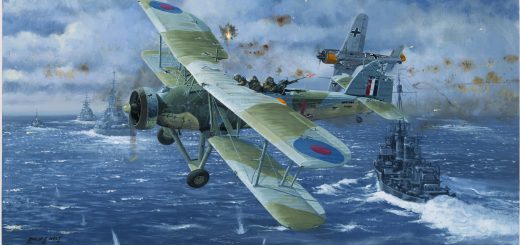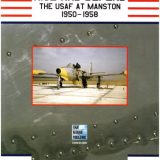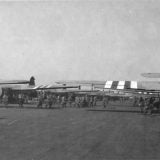The second large attack on Manston during the Battle of Britain, 14th August 1940

At 1140hrs, a large formation of enemy aircraft was detected forming up over Calais by Dover and Pevensey radar. Four squadrons were brought to readiness, including seven Spitfires of No.65 Sqn from Hornchurch, ready at Manston after flying there at 0845hrs. At 1150hrs, the enemy formation took a course towards the North of Dover after varying their direction a number of times over the Channel. Observer Corps reported the formation consisting of 80+ Ju87 Stuka dive bombers from Luftflotte 2 (other reports suggest these were Bf 110s) and a high concentration of Bf 109 escorts in the clouds as cover. At the same time, No.65 Sqn took off from Manston and were the first of the Squadrons to intercept the formation, attracted to the area by Bf 109s shooting down the barrage balloons in flames.
Also on their way to attack were two Staffeln of Bf 110s of Rubensdorffer’s Erprobungsgruppe G1 210 from their base at Calais-Marck, also heading towards Dover.
As No.65 Sqn tried to break up the Ju87s (possibly Bf 110s) at around 1200hrs, the Bf 109s dived down to enter the battle estimated of around 200 aircraft over Dover and just out to sea. With the Luftwaffe being a similar distance from their home bases as the RAF were, they were able to enter more prolonged dogfights than their usual hit and then being forced back to base for fuel. No.615 Sqn (Kenley Hurricanes) lost two pilots, No.32 Sqn (Biggin Hill Hurricanes) three pilots made forced landings while JG26 and JG52 both lost a Bf 109.
No.65 Sqn claimed two enemy aircraft destroyed and two probables, with no loss of their pilots or aircraft. P/O Pyman claimed on Bf 109 and damage to another. His combat report read:
At 1150hrs on the 14th August 1940, 65 Squadron operating from Manston were detailed to intercept raiders in the Channel. I was in the position of Yellow 3 and as such rearmost aircraft of the squadron. When near Dover at 15,000ft I was attacked by a Me109 and in attempting to engage it I became separated from the squadron. While trying to rejoin, I sighted and engaged a Me109 from astern and below. After a 2 second burst from 250yds, it went down in flames, pieces falling away as it went. I then engaged another Me109 and attacking from astern, I fired 2 short bursts from 350yds, no visible effect was seen. While pursuing this enemy aircraft, I was attacked myself and suffered considerable damage. Six (cannon) shells hit my fuselage and one wing, severing the rudder controls completely. The elevator cables and wireless were also hit. A number of bullet holes were found as well. I managed, however, to return to Manston and force-landed, with very little additional damage to my wing-tips.
P/O Pyman used just 960 rounds in the dogfight with Bf 109s but was hit by six 20mm cannon shells and a number of 7.9mm bullets from the MG17 machine guns of the Bf109s. His aircraft would be unserviceable for seven days.
Back at Manston at 1200hrs, many groundcrew thought to include new recruits were sitting with what we might consider nowadays to be shellshock. This would later be suggested as the ‘Manston Mutiny’ some years later, but it would appear that was a case of over dramatising events. It seems clear that during the time of what were severe attacks being witnessed by raw recruits, some may well have understandably, cracked.
With RAF fighters including No.65 Sqn distracted down to Dover, it made it an ideal time for nine Bf 110s of Erprobungsgruppe 210, escorted by Bf 109s of I./JG 52 to arrive at Manston, low and initially unnoticed. The aircraft had travelled just above the waves of the Channel and passed the cliffs of Dover. Part of the attack was planned against Ramsgate Airport, but two large barrage balloons flying over Ramsgate Harbour prevented that attack.
The Bf 110s were greeted by the station’s Bofors 40mm gun manned by the Royal Artillery and machine guns manned by crew members from No.600 Sqn, warned by the air surveillance posts at Dover. Sergeant Thomas William Townshend (801555) of No.600 Squadron and an armourer had been detailed to man airfield guns fitted with ‘homemade’ anti-aircraft weapons consisting of four .303 Browning machine guns, possibly modified from a Blenheim ‘under-fuselage’ pack.

Manston took a heavy battering for the second time in the Battle of Britain. The Bf 110s raced from the south and dropped their bombs over the airfield in a hail of fire back from the defenders, only to make a return run with their machine guns. Two hangers were partially destroyed in the East Camp, damage caused to a Bellman and a Bessonneau hanger and three No.600 Sqn Blenheims. Dispersal huts are also destroyed and a number of further craters left all over the airfield, one large one right in the centre. Two oil bombs were dropped on Manston village.
One of the Bf 110s (S9+MK) piloted by Uffz. Hans Steding was hit by the Bofors removing the tailplane from the fuselage it subsequently collided with the Bf 110 S9+NK of Lt Heinrich Brinkmann and Uffz Richard Mayer, passing underneath it, with both aircraft exploding. Gefr Ewald Schank baled out of S9+MK but due to the low height, sustained injuries when he landed. Uffz Steding remained at the controls and was killed as it crashed and cartwheeled across the airfield, landing inverted. Uffz Brinkmann and Uffz Mayer, killed as their aircraft crashed plus Uffz Steding are buried at Cannock Chase.




Gefr Schank landed right in front of trenches where some RAF personnel were seeking cover and was dragged back to the trench bleeding and concussed. On interrogation, it is said, that he informed that the all out attack was about to come. Richard Collier in his book says that the injured man said in poor English, ‘The big lick’ over and over again. ‘very soon…the big lick’. Richard says that the phrase was plain enough – but just how long before the big lick came. Another author, Christer Bergström suggests “At Manston’s air base the injured and dazed Gefreiter Schank was interrogated. ‘Big things are about to happen soon, very soon’, he told the British“
However, fellow author John Vasco, author of “Erprobungsgruppe 210: ‘Bombsights Over England’” and a researcher trusted by us, suggests that Schank could not speak a word of English at the time, confirmed to him directly in a letter as part of his research.
A third Bf 110, flown by Oberleutnant Werner Weymann was damaged by ground-fire, but managed to return to Calais-Marck on one engine. Another two Bf 110s aborted their attack on Manston midway over the Channel, returning safely to Calais.
Elsewhere, Middle Wallop was attacked by Heinkels from KG 55 and a Ju 88, although references to the aircraft involved differ in some reports.

The Luftwaffe attacks seemed haphazard by RAF High Command. “They’re playing games at the moment” said Air Chief Marshal Hugh Dowding, “they’re not going to achieve anything by these scant and random attacks… I believe that something is building”. Air Vice Marshall Keith Park, in charge of No.11 Group covering London and the South-East agreed “What damage they have done to the airfields has been a setback but they’re still operational”.
Dowding asked Park about the condition of Manston and Middle Wallop and he suggested “like I said, just a setback, I believe that Middle Wallop is at full strength and that Manston will be at 100% strength in twelve hours. In that time we will be ready for them.”

References:
The History of RAF Manston, Flt Lt Rocky Steadman.
www.battleofbritain1940.net
Manston Station ORB.
www.bbm.org.uk
Battle of Britain: An Epic Conflict Revisited by Christer Bergström
Input from John Vasco, author of “Erprobungsgruppe 210: ‘Bombsights Over England’“.
First published: 14th August 2017.
Last Updated: .



















Ewald Schank did not say ‘The big lick’. At the time, he could not speak a word of English.
Source: letter from Ewald Schank to me during my research for my book on Erprobungsgruppe 210: ‘Bombsights Over England’.
Thanks John. Now updated with that added and a few other changes, plus added your book as a post: https://www.manstonhistory.org.uk/erprobungsgruppe-210-bombsights-over-england/